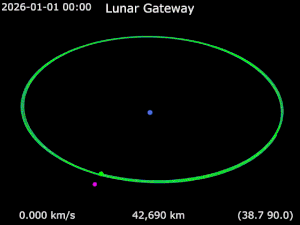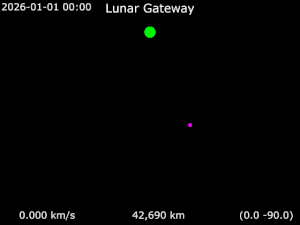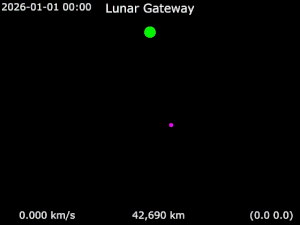Near-rectilinear halo orbit

In
The NRHOs are a subset of the L1 and L2 halo families.[3] This orbit type could also be used with other bodies in the Solar System and beyond.
Association with Lagrange points

A halo orbit is a periodic, three-dimensional orbit associated with one of the L1, L2 and L3
There are four families of NRHO orbits associated with the L1 and L2 points, two each in the northern and southern directions.
Previous and current NRHO missions
CAPSTONE
By 2022, the company
Lunar Flashlight
NASA/JPL's Lunar Flashlight, a cubesat intended to search for water near the lunar south pole, was also planned to use a near-rectilinear halo orbit,[9] but the satellite failed to reach the NRHO.[10]
Planned NRHO usage
Lunar Gateway

By 2018 NASA had begun considering use of a near-rectilinear halo orbit for a future lunar mission,[11][12] and by 2020 an Earth-Moon L2 NRHO had become the planned orbit for the NASA Lunar Gateway. The Gateway orbit will be a 9:2 resonant NRHO,[13] with a period of about 7 days and a high orbital eccentricity, bringing the station within 3,000 kilometers (1,900 mi) of the lunar north pole at closest approach and as far away as 70,000 kilometers (43,000 mi) over the lunar south pole.[14][15][8]
Artemis 3
In 2020 NASA refined its plans for the crewed
Notes
- ^ Whitley, Ryan J.; et al. (2018). "AAS 18-406 EARTH-MOON NEAR RECTILINEAR HALO AND BUTTERFLY ORBITS FOR LUNAR SURFACE EXPLORATION" (PDF).
- ^ Nujoud Merancy (June 2023). "How: NRHO - The Artemis Orbit" (PDF). NASA.
- ^ Spreen, Emily; et al. (May 2017). "NEAR RECTILINEAR HALO ORBITS AND THEIR APPLICATION IN CIS-LUNAR SPACE". IAA.
- ^ "Orbit Maintenance and Navigation of Human Spacecraft at Cislunar Near Rectilinear Halo Orbits". NASA Technical Reports Server. 5 Feb 2017. Retrieved 17 Nov 2022.
- ^ "Near Rectilinear Halo Orbit". 28 March 2020.
- ^ Tavares, Frank (31 May 2022). "CAPSTONE Spacecraft Launch Targeted No Earlier Than June 13". NASA. Retrieved 1 June 2022.
- ^ "CAPSTONE launch delayed to March 2022". 13 October 2021.
- ^ a b Foust, Jeff (16 September 2019). "NASA cubesat to test lunar Gateway orbit". SpaceNews. Retrieved 15 June 2020.
- ^ JPL/NASA (November 28, 2022). "NASA's Lunar Flashlight SmallSat readies for launch".
- ^ Foust, Jeff (August 9, 2023). "Clogged propellant lines doomed NASA lunar cubesat mission". SpaceNews. Retrieved August 10, 2023.
- ^ NASA Shapes Science Plan for Deep-Space Outpost Near the Moon, space.com, March 2018.
- ^ How a New Orbital Moon Station Could Take Us to Mars and Beyond, space.com, October 2017, video with refs
- .
The current nominal orbit for the Gateway is a 9:2 synodic resonant southern L2 NRHO
- ^ Angelic halo orbit chosen for humankind's first lunar outpost, European Space Agency, published by PhysOrg, 19 July 2019, accessed 15 June 2020.
- ^ Halo orbit selected for Gateway space station. David Szondy, New Atlas. 18 July 2019.
- ^ Jeff Foust (14 May 2020). "NASA refines plans for launching Gateway and other Artemis elements". SpaceNews.
References
- Howell, K. C. (1984). "Almost Rectilinear Halo Orbits". Celestial Mechanics. 32 (1): 29–52. S2CID 119855471.
External links
- Angelic halo orbit for Gateway (video), ESA, 17 July 2019. The planned Lunar Gatewayorbit appears a bit like a halo around the Moon from the point of view of an observer on the Earth.



